JEEP GRAND CHEROKEE 2015 WK2 / 4.G Owners Manual
Manufacturer: JEEP, Model Year: 2015, Model line: GRAND CHEROKEE, Model: JEEP GRAND CHEROKEE 2015 WK2 / 4.GPages: 717, PDF Size: 18.54 MB
Page 461 of 717
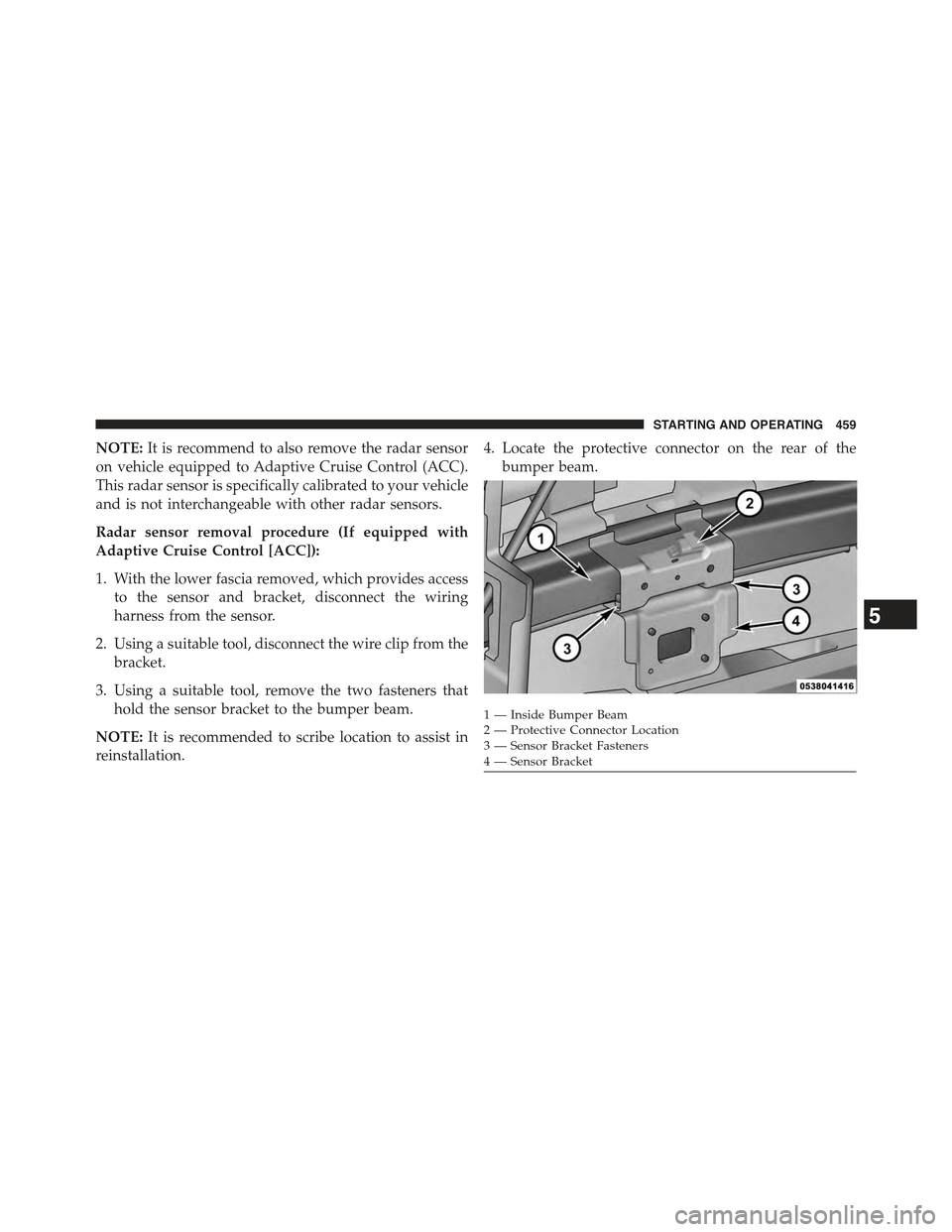
NOTE:It is recommend to also remove the radar sensor
on vehicle equipped to Adaptive Cruise Control (ACC).
This radar sensor is specifically calibrated to your vehicle
and is not interchangeable with other radar sensors.
Radar sensor removal procedure (If equipped with
Adaptive Cruise Control [ACC]):
1. With the lower fascia removed, which provides access
to the sensor and bracket, disconnect the wiring
harness from the sensor.
2. Using a suitable tool, disconnect the wire clip from the
bracket.
3. Using a suitable tool, remove the two fasteners that
hold the sensor bracket to the bumper beam.
NOTE:It is recommended to scribe location to assist in
reinstallation.
4. Locate the protective connector on the rear of the
bumper beam.
1 — Inside Bumper Beam2—ProtectiveConnectorLocation3 — Sensor Bracket Fasteners4 — Sensor Bracket
5
STARTING AND OPERATING 459
Page 462 of 717
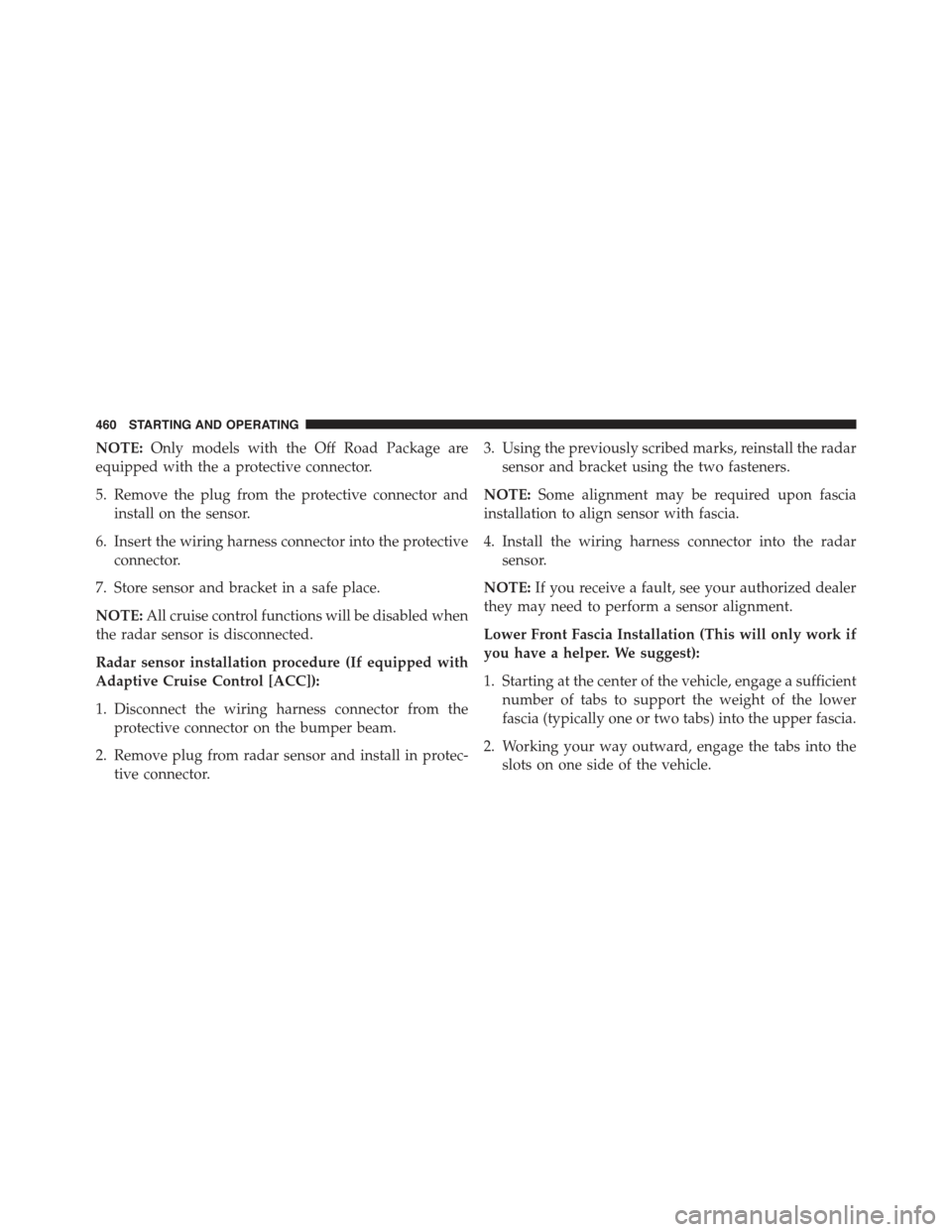
NOTE:Only models with the Off Road Package are
equipped with the a protective connector.
5. Remove the plug from the protective connector and
install on the sensor.
6. Insert the wiring harness connector into the protective
connector.
7. Store sensor and bracket in a safe place.
NOTE:All cruise control functions will be disabled when
the radar sensor is disconnected.
Radar sensor installation procedure (If equipped with
Adaptive Cruise Control [ACC]):
1. Disconnect the wiring harness connector from the
protective connector on the bumper beam.
2. Remove plug from radar sensor and install in protec-
tive connector.
3. Using the previously scribed marks, reinstall the radar
sensor and bracket using the two fasteners.
NOTE:Some alignment may be required upon fascia
installation to align sensor with fascia.
4. Install the wiring harness connector into the radar
sensor.
NOTE:If you receive a fault, see your authorized dealer
they may need to perform a sensor alignment.
Lower Front Fascia Installation (This will only work if
you have a helper. We suggest):
1. Starting at the center of the vehicle, engage a sufficient
number of tabs to support the weight of the lower
fascia (typically one or two tabs) into the upper fascia.
2. Working your way outward, engage the tabs into the
slots on one side of the vehicle.
460 STARTING AND OPERATING
Page 463 of 717
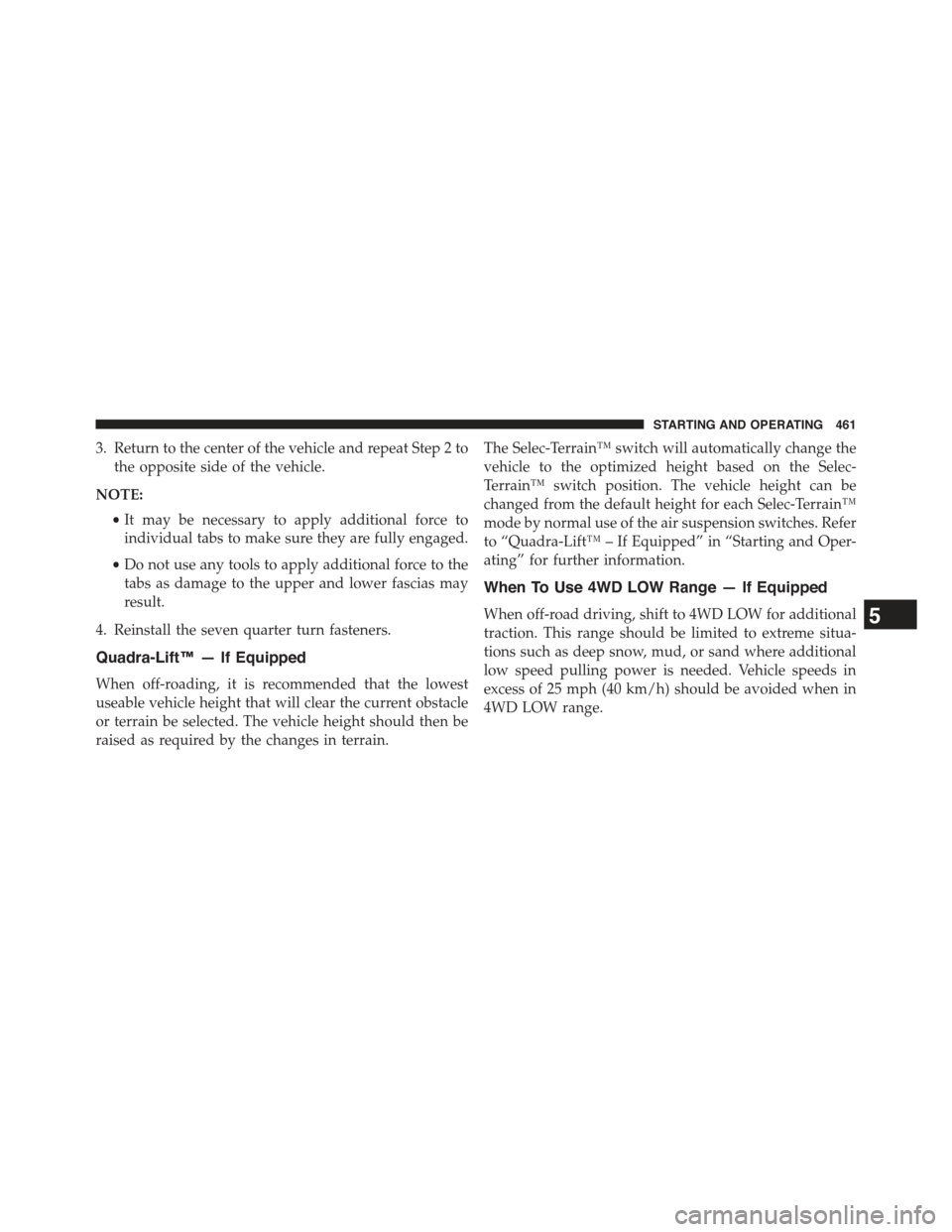
3. Return to the center of the vehicle and repeat Step 2 to
the opposite side of the vehicle.
NOTE:
•It may be necessary to apply additional force to
individual tabs to make sure they are fully engaged.
•Do not use any tools to apply additional force to the
tabs as damage to the upper and lower fascias may
result.
4. Reinstall the seven quarter turn fasteners.
Quadra-Lift™ — If Equipped
When off-roading, it is recommended that the lowest
useable vehicle height that will clear the current obstacle
or terrain be selected. The vehicle height should then be
raised as required by the changes in terrain.
The Selec-Terrain™ switch will automatically change the
vehicle to the optimized height based on the Selec-
Terrain™ switch position. The vehicle height can be
changed from the default height for each Selec-Terrain™
mode by normal use of the air suspension switches. Refer
to “Quadra-Lift™ – If Equipped” in “Starting and Oper-
ating” for further information.
When To Use 4WD LOW Range — If Equipped
When off-road driving, shift to 4WD LOW for additional
traction. This range should be limited to extreme situa-
tions such as deep snow, mud, or sand where additional
low speed pulling power is needed. Vehicle speeds in
excess of 25 mph (40 km/h) should be avoided when in
4WD LOW range.
5
STARTING AND OPERATING 461
Page 464 of 717
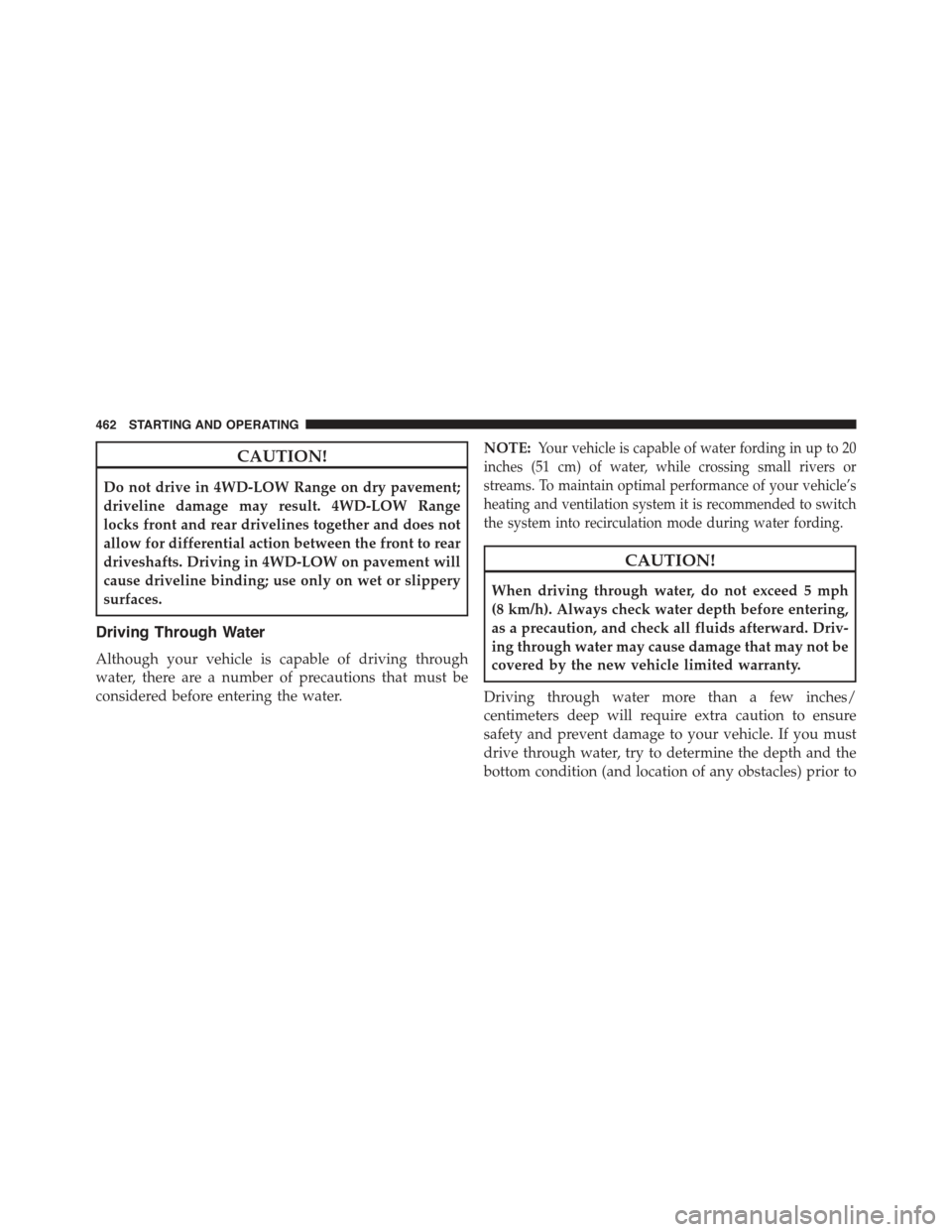
CAUTION!
Do not drive in 4WD-LOW Range on dry pavement;
driveline damage may result. 4WD-LOW Range
locks front and rear drivelines together and does not
allow for differential action between the front to rear
driveshafts. Driving in 4WD-LOW on pavement will
cause driveline binding; use only on wet or slippery
surfaces.
Driving Through Water
Although your vehicle is capable of driving through
water, there are a number of precautions that must be
considered before entering the water.
NOTE:Your vehicle is capable of water fording in up to 20
inches (51 cm) of water, while crossing small rivers or
streams. To maintain optimal performance of your vehicle’s
heating and ventilation system it is recommended to switch
the system into recirculation mode during water fording.
CAUTION!
When driving through water, do not exceed 5 mph
(8 km/h). Always check water depth before entering,
as a precaution, and check all fluids afterward. Driv-
ing through water may cause damage that may not be
covered by the new vehicle limited warranty.
Driving through water more than a few inches/
centimeters deep will require extra caution to ensure
safety and prevent damage to your vehicle. If you must
drive through water, try to determine the depth and the
bottom condition (and location of any obstacles) prior to
462 STARTING AND OPERATING
Page 465 of 717
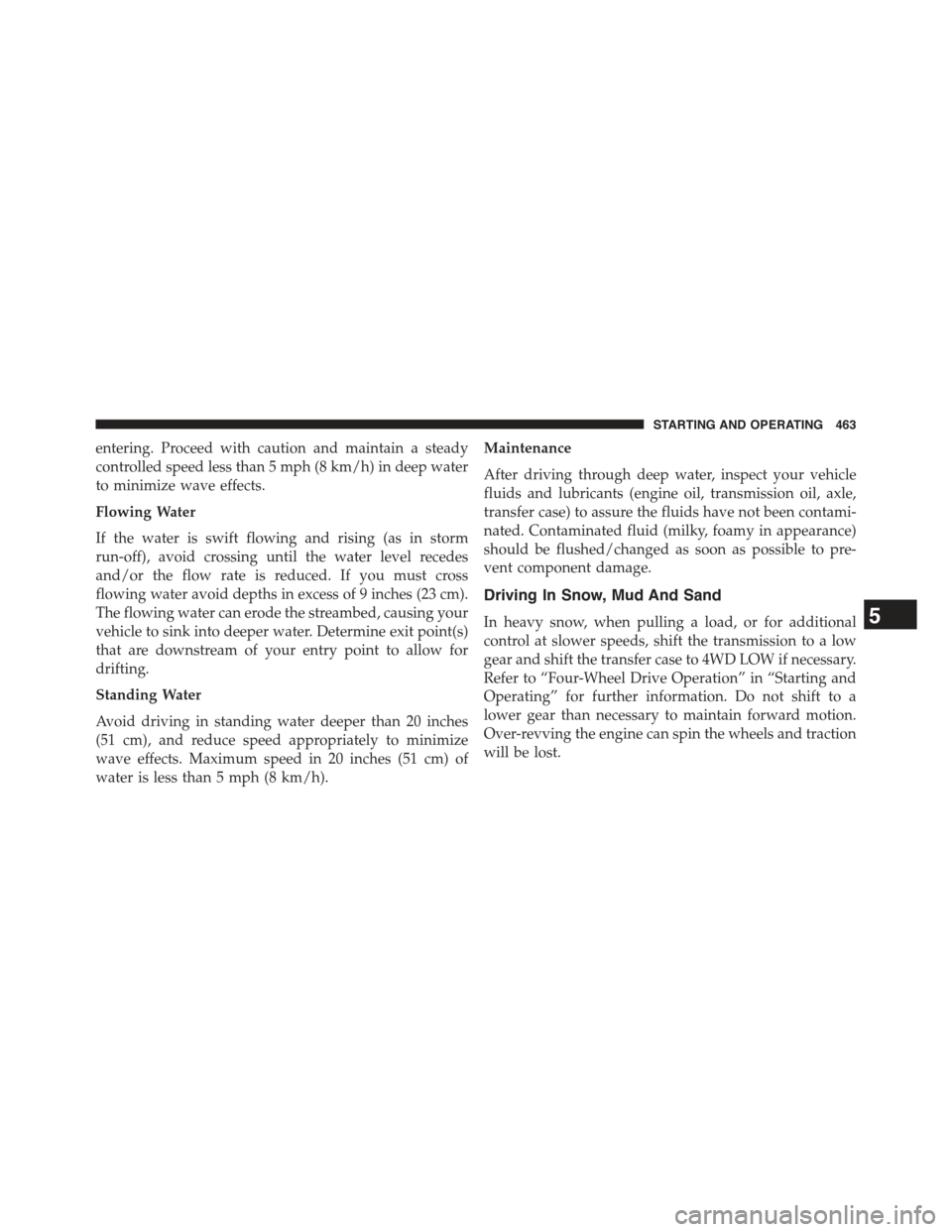
entering. Proceed with caution and maintain a steady
controlled speed less than 5 mph (8 km/h) in deep water
to minimize wave effects.
Flowing Water
If the water is swift flowing and rising (as in storm
run-off), avoid crossing until the water level recedes
and/or the flow rate is reduced. If you must cross
flowing water avoid depths in excess of 9 inches (23 cm).
The flowing water can erode the streambed, causing your
vehicle to sink into deeper water. Determine exit point(s)
that are downstream of your entry point to allow for
drifting.
Standing Water
Avoid driving in standing water deeper than 20 inches
(51 cm), and reduce speed appropriately to minimize
wave effects. Maximum speed in 20 inches (51 cm) of
water is less than 5 mph (8 km/h).
Maintenance
After driving through deep water, inspect your vehicle
fluids and lubricants (engine oil, transmission oil, axle,
transfer case) to assure the fluids have not been contami-
nated. Contaminated fluid (milky, foamy in appearance)
should be flushed/changed as soon as possible to pre-
vent component damage.
Driving In Snow, Mud And Sand
In heavy snow, when pulling a load, or for additional
control at slower speeds, shift the transmission to a low
gear and shift the transfer case to 4WD LOW if necessary.
Refer to “Four-Wheel Drive Operation” in “Starting and
Operating” for further information. Do not shift to a
lower gear than necessary to maintain forward motion.
Over-revving the engine can spin the wheels and traction
will be lost.
5
STARTING AND OPERATING 463
Page 466 of 717
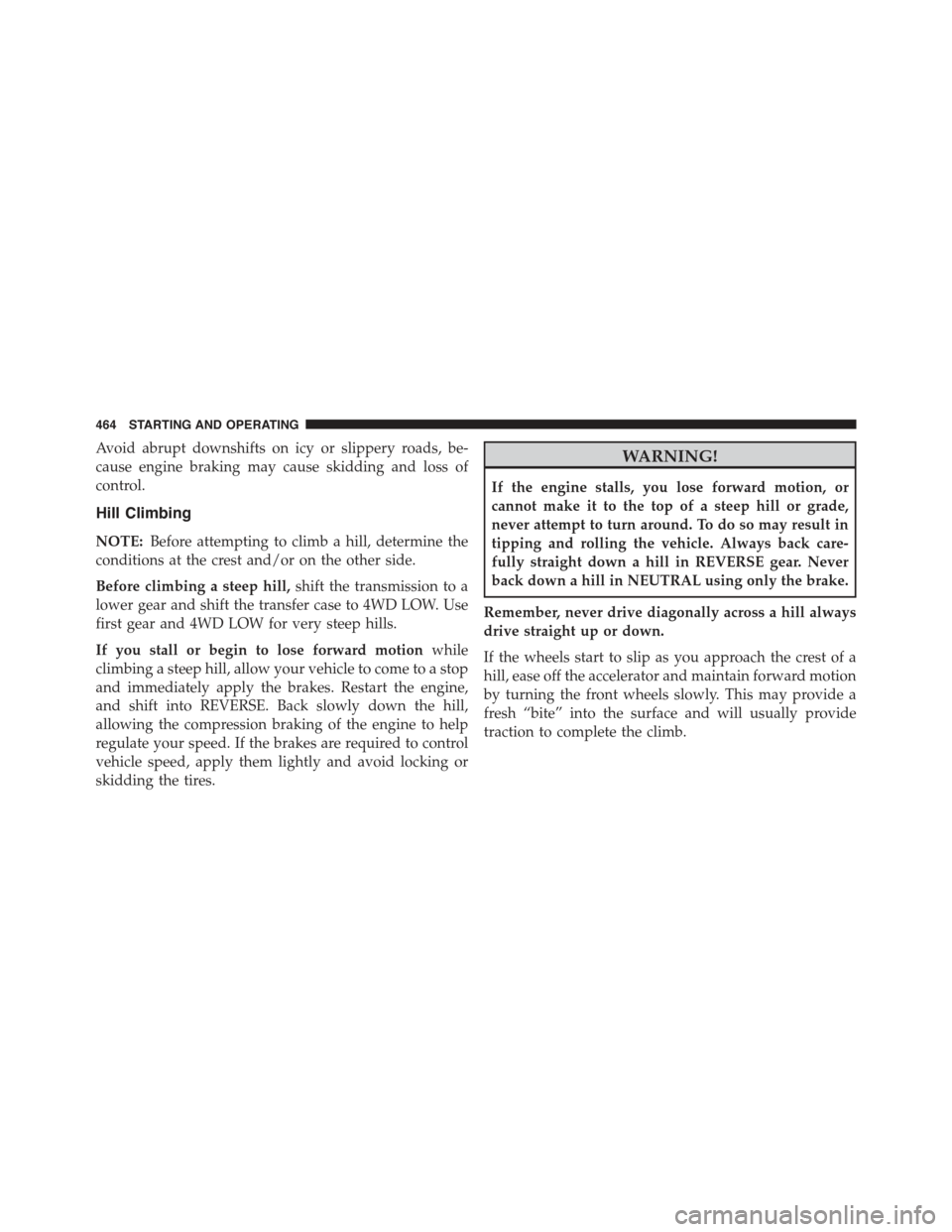
Avoid abrupt downshifts on icy or slippery roads, be-
cause engine braking may cause skidding and loss of
control.
Hill Climbing
NOTE:Before attempting to climb a hill, determine the
conditions at the crest and/or on the other side.
Before climbing a steep hill,shift the transmission to a
lower gear and shift the transfer case to 4WD LOW. Use
first gear and 4WD LOW for very steep hills.
If you stall or begin to lose forward motionwhile
climbing a steep hill, allow your vehicle to come to a stop
and immediately apply the brakes. Restart the engine,
and shift into REVERSE. Back slowly down the hill,
allowing the compression braking of the engine to help
regulate your speed. If the brakes are required to control
vehicle speed, apply them lightly and avoid locking or
skidding the tires.
WARNING!
If the engine stalls, you lose forward motion, or
cannot make it to the top of a steep hill or grade,
never attempt to turn around. To do so may result in
tipping and rolling the vehicle. Always back care-
fully straight down a hill in REVERSE gear. Never
back down a hill in NEUTRAL using only the brake.
Remember, never drive diagonally across a hill always
drive straight up or down.
If the wheels start to slip as you approach the crest of a
hill, ease off the accelerator and maintain forward motion
by turning the front wheels slowly. This may provide a
fresh “bite” into the surface and will usually provide
traction to complete the climb.
464 STARTING AND OPERATING
Page 467 of 717
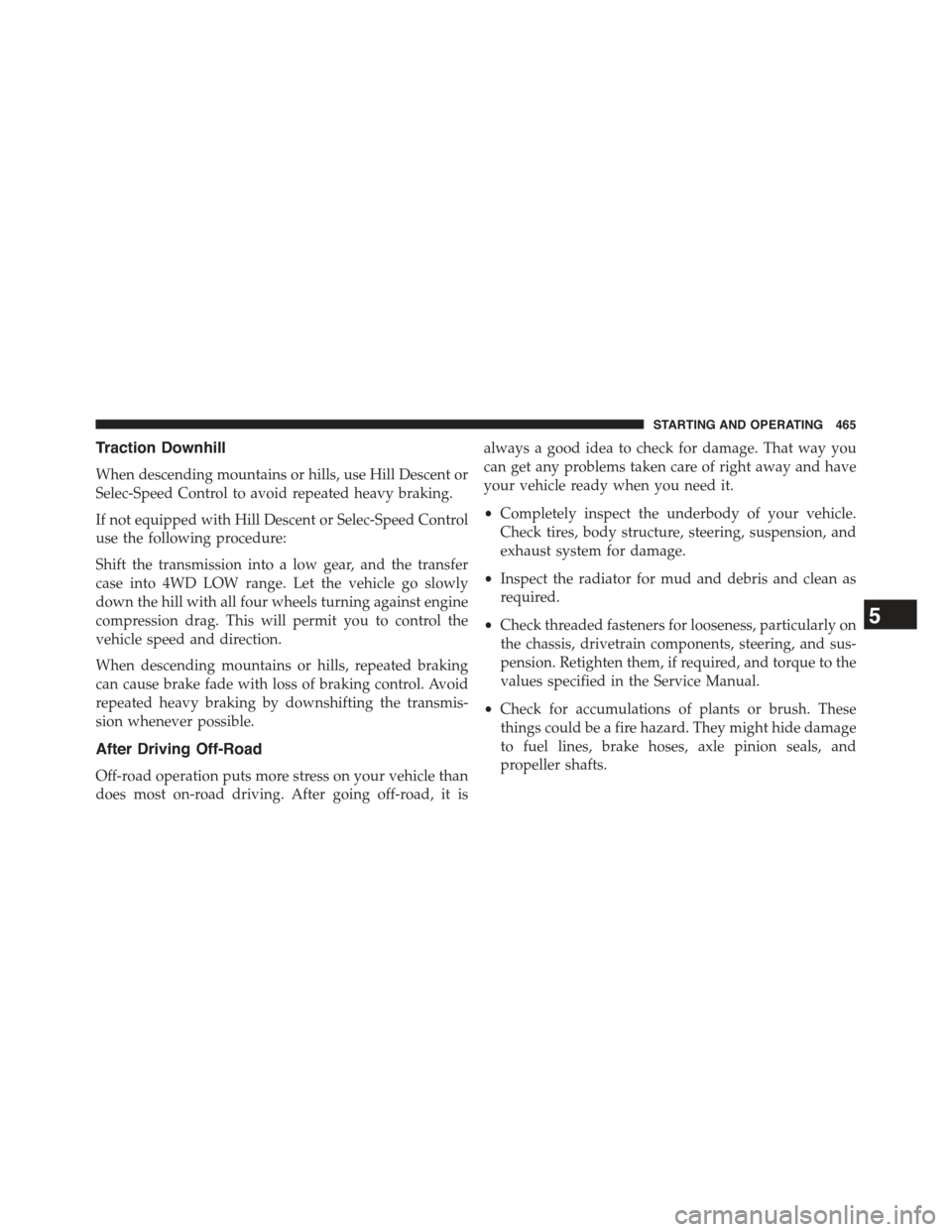
Traction Downhill
When descending mountains or hills, use Hill Descent or
Selec-Speed Control to avoid repeated heavy braking.
If not equipped with Hill Descent or Selec-Speed Control
use the following procedure:
Shift the transmission into a low gear, and the transfer
case into 4WD LOW range. Let the vehicle go slowly
down the hill with all four wheels turning against engine
compression drag. This will permit you to control the
vehicle speed and direction.
When descending mountains or hills, repeated braking
can cause brake fade with loss of braking control. Avoid
repeated heavy braking by downshifting the transmis-
sion whenever possible.
After Driving Off-Road
Off-road operation puts more stress on your vehicle than
does most on-road driving. After going off-road, it is
always a good idea to check for damage. That way you
can get any problems taken care of right away and have
your vehicle ready when you need it.
•Completely inspect the underbody of your vehicle.
Check tires, body structure, steering, suspension, and
exhaust system for damage.
•Inspect the radiator for mud and debris and clean as
required.
•Check threaded fasteners for looseness, particularly on
the chassis, drivetrain components, steering, and sus-
pension. Retighten them, if required, and torque to the
values specified in the Service Manual.
•Check for accumulations of plants or brush. These
things could be a fire hazard. They might hide damage
to fuel lines, brake hoses, axle pinion seals, and
propeller shafts.
5
STARTING AND OPERATING 465
Page 468 of 717
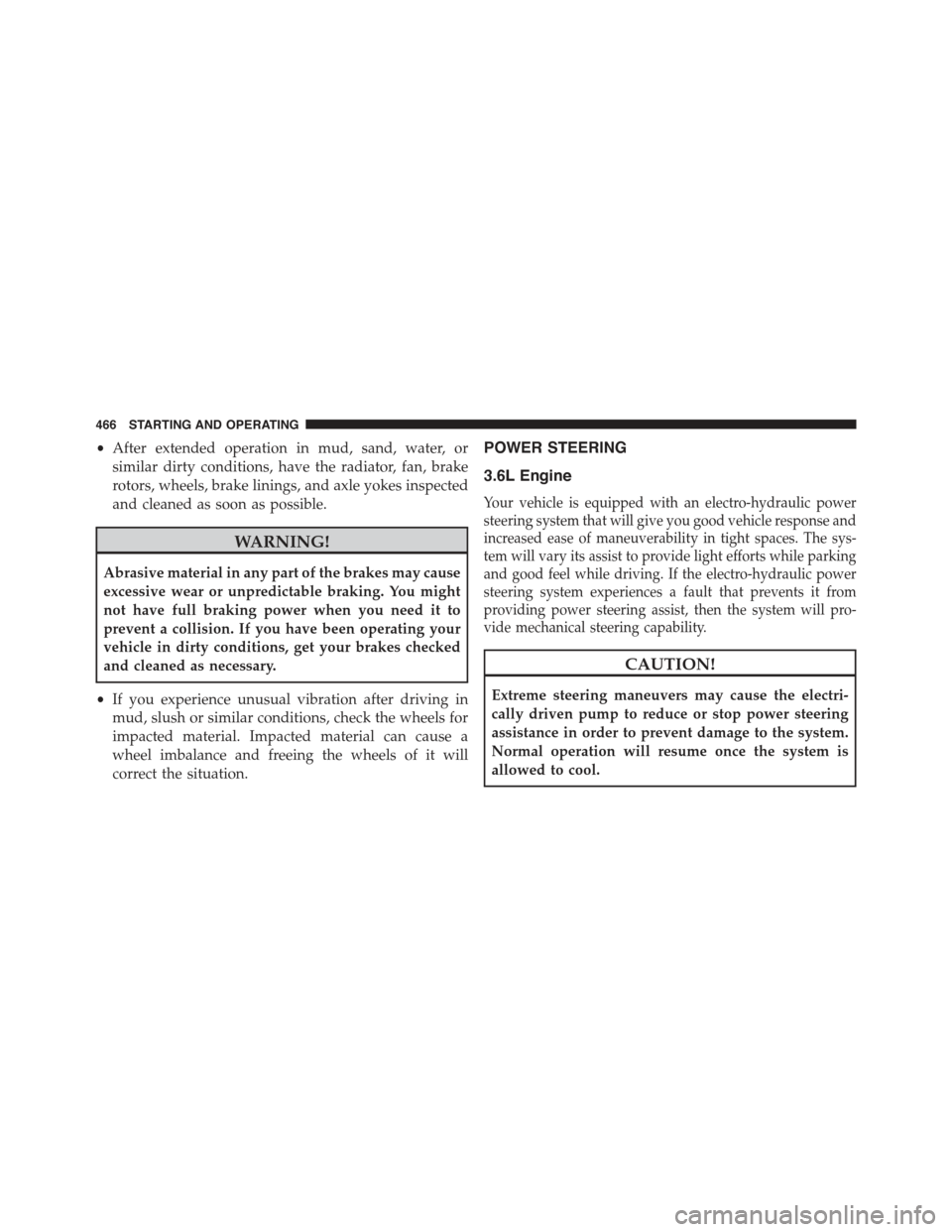
•After extended operation in mud, sand, water, or
similar dirty conditions, have the radiator, fan, brake
rotors, wheels, brake linings, and axle yokes inspected
and cleaned as soon as possible.
WARNING!
Abrasive material in any part of the brakes may cause
excessive wear or unpredictable braking. You might
not have full braking power when you need it to
prevent a collision. If you have been operating your
vehicle in dirty conditions, get your brakes checked
and cleaned as necessary.
•If you experience unusual vibration after driving in
mud, slush or similar conditions, check the wheels for
impacted material. Impacted material can cause a
wheel imbalance and freeing the wheels of it will
correct the situation.
POWER STEERING
3.6L Engine
Your vehicle is equipped with an electro-hydraulic power
steering system that will give you good vehicle response and
increased ease of maneuverability in tight spaces. The sys-
tem will vary its assist to provide light efforts while parking
and good feel while driving. If the electro-hydraulic power
steering system experiences a fault that prevents it from
providing power steering assist, then the system will pro-
vide mechanical steering capability.
CAUTION!
Extreme steering maneuvers may cause the electri-
cally driven pump to reduce or stop power steering
assistance in order to prevent damage to the system.
Normal operation will resume once the system is
allowed to cool.
466 STARTING AND OPERATING
Page 469 of 717
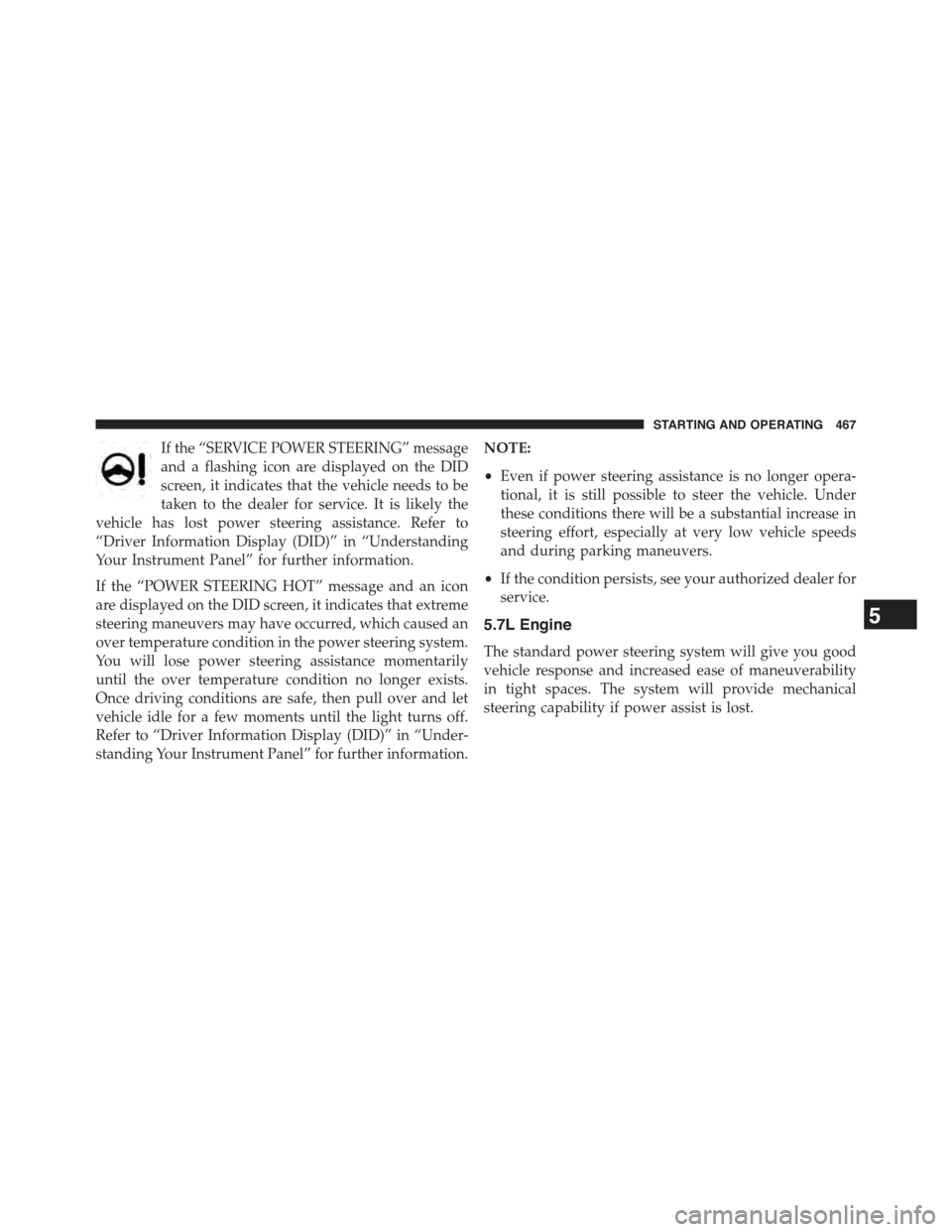
If the “SERVICE POWER STEERING” message
and a flashing icon are displayed on the DID
screen, it indicates that the vehicle needs to be
taken to the dealer for service. It is likely the
vehicle has lost power steering assistance. Refer to
“Driver Information Display (DID)” in “Understanding
Your Instrument Panel” for further information.
If the “POWER STEERING HOT” message and an icon
are displayed on the DID screen, it indicates that extreme
steering maneuvers may have occurred, which caused an
over temperature condition in the power steering system.
You will lose power steering assistance momentarily
until the over temperature condition no longer exists.
Once driving conditions are safe, then pull over and let
vehicle idle for a few moments until the light turns off.
Refer to “Driver Information Display (DID)” in “Under-
standing Your Instrument Panel” for further information.
NOTE:
•Even if power steering assistance is no longer opera-
tional, it is still possible to steer the vehicle. Under
these conditions there will be a substantial increase in
steering effort, especially at very low vehicle speeds
and during parking maneuvers.
•If the condition persists, see your authorized dealer for
service.
5.7L Engine
The standard power steering system will give you good
vehicle response and increased ease of maneuverability
in tight spaces. The system will provide mechanical
steering capability if power assist is lost.
5
STARTING AND OPERATING 467
Page 470 of 717
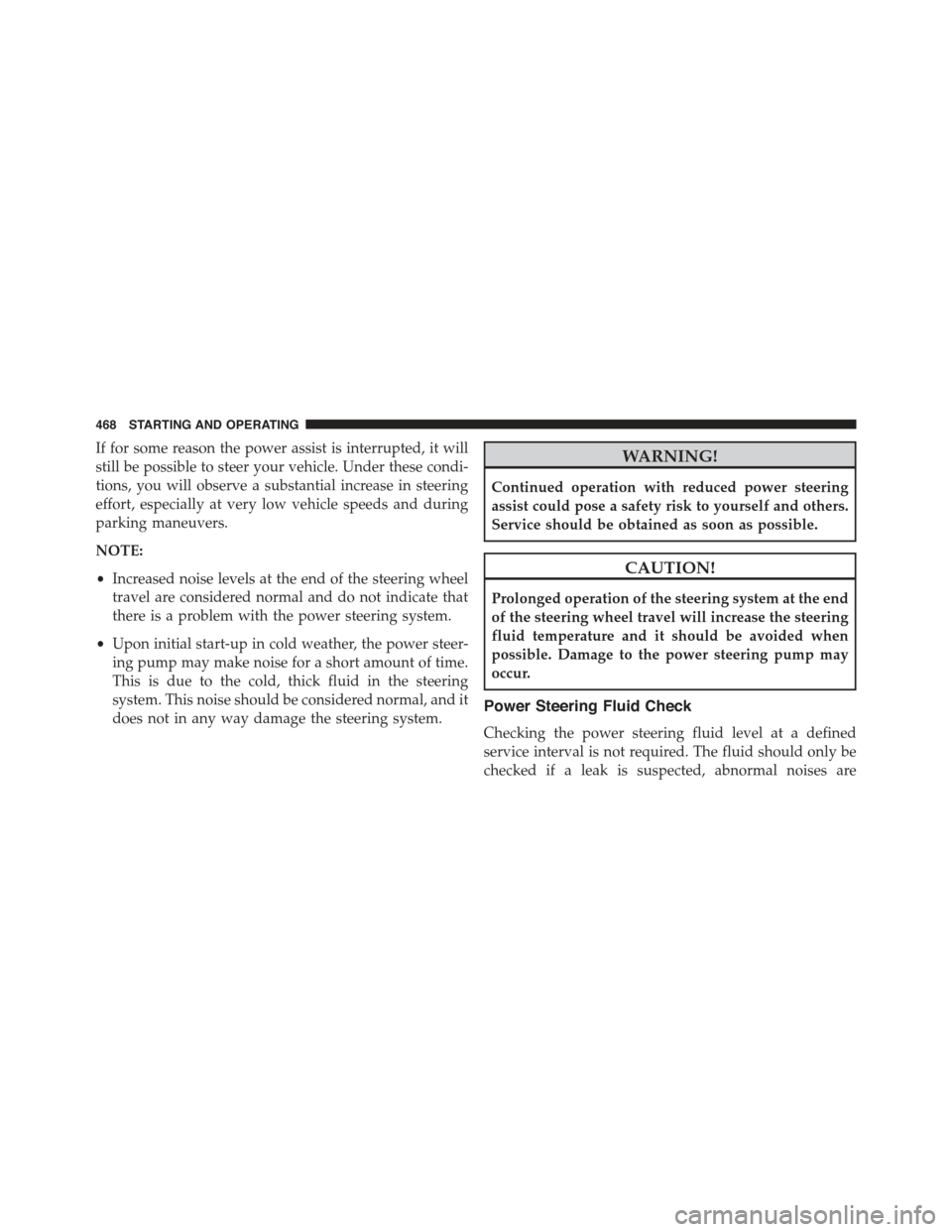
If for some reason the power assist is interrupted, it will
still be possible to steer your vehicle. Under these condi-
tions, you will observe a substantial increase in steering
effort, especially at very low vehicle speeds and during
parking maneuvers.
NOTE:
•Increased noise levels at the end of the steering wheel
travel are considered normal and do not indicate that
there is a problem with the power steering system.
•Upon initial start-up in cold weather, the power steer-
ing pump may make noise for a short amount of time.
This is due to the cold, thick fluid in the steering
system. This noise should be considered normal, and it
does not in any way damage the steering system.
WARNING!
Continued operation with reduced power steering
assist could pose a safety risk to yourself and others.
Service should be obtained as soon as possible.
CAUTION!
Prolonged operation of the steering system at the end
of the steering wheel travel will increase the steering
fluid temperature and it should be avoided when
possible. Damage to the power steering pump may
occur.
Power Steering Fluid Check
Checking the power steering fluid level at a defined
service interval is not required. The fluid should only be
checked if a leak is suspected, abnormal noises are
468 STARTING AND OPERATING